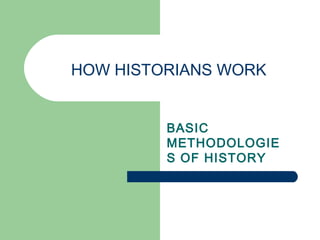
C3 - How Historians Work
- 1. HOW HISTORIANS WORK BASIC METHODOLOGIE S OF HISTORY
- 2. Sources / Evidences Historical Sources Primary Sources Forms of Primary Sources Secondary Sources Reliability of Primary Sources Historiography Methods of Historical Analysis / Writing History Problems in Historical Analysis / Writing History
- 3. Sources / Evidences History is about evidence – interpretation of evidence. No evidence – no history. The surviving evidence must be fallible or reliable. The nature or forms of evidence. The changing nature of evidence, e.g. from letters to tapes/ recordings.
- 4. Sources / Evidences The question of also how much evidence, either too much or too little. Too much evidence, esp. for the modern or early modern period events. Too little evidence for ancient periods.
- 5. Historical Sources Sources Primary Source Secondary Source
- 6. Primary Sources Primary sources are first hand evidences by eyewitness accounts come from people who saw or participated in the historical events that are being analyzed. Various forms of primary sources. 2 main criteria of primary sources: 1. authentic/ original. 2. contemporary (of the time under study).
- 7. Forms of Primary Sources Forms of Primary Sources Physical Artifacts Visual Images Oral and audio Statistics Printed Document Unpublished manuscript
- 8. Forms of Primary Sources 1. Physical Artifacts: such as tools, weapons, machines, toys, uniforms, tombstones, etc. 2. Visual Images: such as photographs, film, video, paintings, sculpture, cave drawings, maps, etc.
- 9. Forms of Primary Sources
- 10. Forms of Primary Sources A painting of a bank scene, Florence, painted by Niccolo di Pietro Gerini (14th-15th c),
- 11. Forms of Primary Sources 3.Oral and audio evidence: such as live interviews and audio recordings, songs, poems, etc. 4. Statistics: such as census data, figures on the economy, land surveys, account books, etc. 5. Printed text documents: such as cookbooks, traveler's reports, advertisements, memoirs, government publication, etc.
- 12. Forms of Primary Sources 6.Manuscript (handwritten) documents: such as diaries, journals, letters, etc.
- 13. Forms of Primary Sources
- 14. Secondary Sources Secondary sources: Second-hand evidences, provided by persons not present during the historical time under discussion. Most of books you read are secondary sources. Good historians combine a wide range of primary sources with a careful reading of the ideas of other scholars in secondary sources.
- 15. Secondary Sources Among secondary sources, we prefer SCHOLARLY sources. Scholarly books and articles use footnotes or endnotes to show where the information comes from.
- 16. Reliability of Primary Sources Does it accurately reflect the historical past? To determine that we need to apply the tests of reliability. 1. Authenticity of the sources. Is the evidence what it appears to be or is it possibly a fraud or forgery? How to determine it?
- 17. Reliability of Primary Sources Depends on the type of evidence. E.g. written documents - scientific proof of the age of the antique documents & the use of language. i) Test the age of document - scientific test, e.g. radio carbon-dating analysis. ii) analyze the language structure, e.g. by linguists.
- 18. Reliability of Primary Sources 2. Identity of the author/ source. Is the author or source clearly identified? His/her position? Title? Historians do not rely on "anonymous" sources or hearsay. 3. Reliability of the author/ source. Is the source qualified to provide this evidence?
- 19. Reliability of Primary Sources Sources may be qualified by training/education or by experience with the topic of the evidence. Cf. in ‘Ilm hadith, Ilm Al-Rijal. 4. Bias. Does the author have a vested interest in the topic of the evidence that might distort the evidence?
- 20. Reliability of Primary Sources 5. External Consistency. Is the evidence consistent with outside qualified sources?
- 21. Reliability of Primary Sources Identity of Sources Bias External Consistency Reliability Of Sources Authentic Or Fraud? Test of Reliability
- 22. Reliability of Primary Sources E.g. Islamization of North Sumatera. Various sources. E.g., Marco Polo who transited there in 1292 - only Perlak had a very few Muslims & other areas idolaters & cannibals. Chinese sources - Samudra, which Marco argues idolaters were Muslims at least well before 1280s.
- 23. Reliability of Primary Sources Local source - Hikayat Raja-Raja Pasai - as early as 13 century the islamization process had taken place. The King changed his name from Merah Silau to a Muslim name, Sultan Malik Saleh. Artifact – Sultan Malik Salih’s gravestone dated 1297.
- 24. The Famous Malikus Salih Gravestone, dated 1297. The grave complex is located at Desa Beringin, Samudera, 17 Km, east of Lhokseumawe
- 25. Historiography The study of the way history has been and is written – the history of historical writing. The analysis usually focuses on the interpretations, worldviews, use of evidence, or method of presentation of other historians. When you study ‘historiography’ you do not study the events of the past directly, but the changing interpretations of those events in the works of individual historians.
- 26. Methods of Historical Analysis/ Writing History 1. The selection of a subject for investigation. 2. The collection of probable sources of information on that subject. 3. The examination of those sources for genuineness. 4. The extraction of credible particulars from the sources (or parts of sources) proved genuine.
- 27. Problems in Historical Analysis / Writing History Historians not being critical or objective. Influenced by own ideologies, views, beliefs,etc. Biased information or sources. Through ages, the truth had often been manipulated or covered esp. by past rulers or politicians for their own interests. Forged evidence.
- 28. Problems in Historical Analysis / Writing History Difficulty to record on the lives of general masses. The accounts or documents are mainly concerned with rulers, aristocrats, kings, politics and systems of government. Lack of observation on common people, peasants, slaves, etc.
